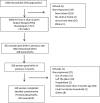Why women choose to give birth at home: a situational analysis from urban slums of Delhi
- PMID: 24852297
- PMCID: PMC4039791
- DOI: 10.1136/bmjopen-2013-004401
Why women choose to give birth at home: a situational analysis from urban slums of Delhi
Abstract
Objectives: Increasing institutional births is an important strategy for attaining Millennium Development Goal -5. However, rapid growth of low income and migrant populations in urban settings in low-income and middle-income countries, including India, presents unique challenges for programmes to improve utilisation of institutional care. Better understanding of the factors influencing home or institutional birth among the urban poor is urgently needed to enhance programme impact. To measure the prevalence of home and institutional births in an urban slum population and identify factors influencing these events.
Design: Cross-sectional survey using quantitative and qualitative methods.
Setting: Urban poor settlements in Delhi, India.
Participants: A house-to-house survey was conducted of all households in three slum clusters in north-east Delhi (n=32 034 individuals). Data on birthing place and sociodemographic characteristics were collected using structured questionnaires (n=6092 households). Detailed information on pregnancy and postnatal care was obtained from women who gave birth in the past 3 months (n=160). Focus group discussions and in-depth interviews were conducted with stakeholders from the community and healthcare facilities.
Results: Of the 824 women who gave birth in the previous year, 53% (95% CI 49.7 to 56.6) had given birth at home. In adjusted analyses, multiparity, low literacy and migrant status were independently predictive of home births. Fear of hospitals (36%), comfort of home (20.7%) and lack of social support for child care (12.2%) emerged as the primary reasons for home births.
Conclusions: Home births are frequent among the urban poor. This study highlights the urgent need for improvements in the quality and hospitality of client services and need for family support as the key modifiable factors affecting over two-thirds of this population. These findings should inform the design of strategies to promote institutional births.
Keywords: Public Health; Qualitative REsearch; Quality in health care.
Published by the BMJ Publishing Group Limited. For permission to use (where not already granted under a licence) please go to http://group.bmj.com/group/rights-licensing/permissions.
Figures
Similar articles
-
Prospective study of determinants and costs of home births in Mumbai slums.BMC Pregnancy Childbirth. 2010 Jul 30;10:38. doi: 10.1186/1471-2393-10-38. BMC Pregnancy Childbirth. 2010. PMID: 20670456 Free PMC article.
-
Determinants of institutional childbirth service utilisation among women of childbearing age in urban and rural areas of Tsegedie district, Ethiopia.Midwifery. 2014 Nov;30(11):1109-17. doi: 10.1016/j.midw.2014.03.009. Epub 2014 Mar 25. Midwifery. 2014. PMID: 24726608
-
Birth preparedness and determinants of birth place among migrants living in slums and slum-like pockets in Delhi, India.Sex Reprod Healthc. 2018 Jun;16:160-166. doi: 10.1016/j.srhc.2018.04.004. Epub 2018 Apr 9. Sex Reprod Healthc. 2018. PMID: 29804761
-
Nutritional interventions for preventing stunting in children (birth to 59 months) living in urban slums in low- and middle-income countries (LMIC).Cochrane Database Syst Rev. 2019 Jun 17;6(6):CD011695. doi: 10.1002/14651858.CD011695.pub2. Cochrane Database Syst Rev. 2019. PMID: 31204795 Free PMC article.
-
Experiences of women who have planned unassisted home births in high-resource countries: a qualitative systematic review.JBI Evid Synth. 2023 Sep 1;21(9):1732-1763. doi: 10.11124/JBIES-22-00246. JBI Evid Synth. 2023. PMID: 37114867
Cited by
-
Development of an Artificial Intelligence-Guided Citizen-Centric Predictive Model for the Uptake of Maternal Health Services Among Pregnant Women Living in Urban Slum Settings in India: Protocol for a Cross-sectional Study With a Mixed Methods Design.JMIR Res Protoc. 2023 Jan 27;12:e35452. doi: 10.2196/35452. JMIR Res Protoc. 2023. PMID: 36705968 Free PMC article.
-
Identification of priority health conditions for field-based screening in urban slums in Bangalore, India.BMC Public Health. 2018 Mar 2;18(1):309. doi: 10.1186/s12889-018-5194-2. BMC Public Health. 2018. PMID: 29499698 Free PMC article.
-
Reproductive healthcare utilization in urban poor settlements of Delhi: Baseline survey of ANCHUL (Ante Natal and Child Health care in Urban Slums) project.BMC Pregnancy Childbirth. 2015 Sep 8;15:212. doi: 10.1186/s12884-015-0635-8. BMC Pregnancy Childbirth. 2015. PMID: 26350040 Free PMC article.
-
Healthcare providers perceptions regarding the presence of Birth Companion during childbirth at a tertiary care hospital in India.BMC Pregnancy Childbirth. 2023 Mar 10;23(1):159. doi: 10.1186/s12884-022-05327-1. BMC Pregnancy Childbirth. 2023. PMID: 36899298 Free PMC article.
-
Why do women not use skilled birth attendance service? An explorative qualitative study in north West Ethiopia.BMC Pregnancy Childbirth. 2020 Oct 19;20(1):633. doi: 10.1186/s12884-020-03312-0. BMC Pregnancy Childbirth. 2020. PMID: 33076867 Free PMC article.
References
-
- Ronsmans C, Graham WJ; Lancet Maternal Survival Series steering group. Maternal mortality: who, when, where, and why. Lancet 2006;368:1189–200 - PubMed
-
- Koblinsky M, Matthews Z, Hussein J, et al. Going to scale with professional skilled care. Lancet 2006;368:1377–86 - PubMed
-
- Campbell OM, Graham WJ; Lancet Maternal Survival Series steering group. Strategies for reducing maternal mortality: getting on with what works. Lancet 2006;368:1284–99 - PubMed
Publication types
MeSH terms
LinkOut - more resources
Full Text Sources
Other Literature Sources
Miscellaneous


